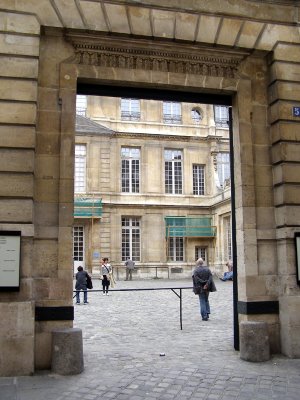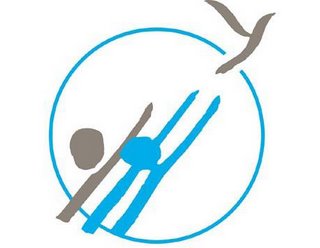
1. On rue St-Antoine, a block from where I'm staying, there is a natural honey store, Miel et Nature, right next to a butcher that sells horsemeat, Au Cheval du Marais. I wonder how the natural honey-buyers feel shopping next to this boucherie? I was a bit disturbed just walking by, even though I eat (other) meat.
Frenchmen began eating horsemeat, ”they say, during the Battle of Eylau in 1807, when the surgeon-in-chief of Napoleon's Grand Army, Baron Dominique-Jean Larrey, advised the starving troops to eat the flesh of dead battlefield horses. The cavalry used breastplates as cooking pans and gunpowder as seasoning, and thus founded a tradition.” (from this article)
Ok, stay with me.

Doorway into the courtyard of the Picasso Museum
2. At the Picasso museum in Paris, also in this neighborhood, there is a visiting photographic exhibit of Picasso’s mistress and friend, Dora Maar, with her photographs of him and his work, including the photographic series she took while he painted Guernica. Guernica (below) is Picasso’s anti-war painting against the April 27th, 1937 atrocities perpetrated on behalf of Franco against the civilian population of a little Basque village in northern Spain. By May 1 of 1937, a million protestors against this horrific act flooded the streets of Paris, where Picasso was living and painting. He had been commissioned to paint a mural for the Spanish Pavilion at the Paris Exhibition in 1937. Previously avoiding politics (though disturbed by the turmoil in his home country, Spain), in response to the terrible massacre at Guernica he painted this painting for the Spanish Pavilion. Imagine!

“The central figure in Guernica is a horse run through with a javelin, wrenched in agony. Some interpreted the horse as Franco's Nationalism, with Picasso predicting its downfall. But other, opposite meanings make more sense in the overall context. The portrayal of the people as a helpless animal dying a senseless death, without the light of hope, is certainly a disturbing idea.” (from this article)
It was not until after Picasso's death (1973), and after the death of Franco (1975), who had instigated the massacre in Spain, that Picasso's painting Guernica was sent to Spain, because Picasso wanted it to belong to the Spanish people, but not while Spain was ruled by a dictator. It is now housed in the Reina Sofía, Spain's national museum of modern art.
Bear with me just a little bit more.
3. I also found out today about ATD Fourth World, a non-governmental humanitarian organization based in France that believes everybody, especially society's poorest members, needs culture as well as bread (fundamentally the ability to read and write, but also the arts).
This article in Mondialogo says "That is the basic tenet of ATD (Aid in Total Distress), which w as founded in 1957 in a camp for homeless families in the Paris suburb of Noisy-le-Grand by Father Joseph Wresinski. First the priest invited actors to perform Sophocles’ Antigone in the muddy, ramshackle settlement. Then he laid on an exhibition of original works by Picasso, Braque, Miro and Léger. 'Culture is a fundamental right,' said Father Wresinski, 'but the shame the poorest people have to endure cuts them off from that right.' He wanted culture 'to cease to be a privilege' and to help people outside mainstream society 'believe in their own culture and in their intelligence.'"
as founded in 1957 in a camp for homeless families in the Paris suburb of Noisy-le-Grand by Father Joseph Wresinski. First the priest invited actors to perform Sophocles’ Antigone in the muddy, ramshackle settlement. Then he laid on an exhibition of original works by Picasso, Braque, Miro and Léger. 'Culture is a fundamental right,' said Father Wresinski, 'but the shame the poorest people have to endure cuts them off from that right.' He wanted culture 'to cease to be a privilege' and to help people outside mainstream society 'believe in their own culture and in their intelligence.'"
This is just me responding to a day in Paris when honey, dead horses and Picasso were seen in more than one place.


 Paris Time
Paris Time

9 comments:
What a day of juxtaposition, Ruth! And on Mother's Day at that. You do have a way of tying it all together!
Happy Mother's Day one day late, Ginnie/Boots!
We eat horsemeat also in Québec but this is not mainstream. It is a tasty alternative to beef. Personnally, I like it. I didn't know about ATD and I find it is a good initiative
Mei, just one of the many meats I haven't tried, but are eaten around the world.
Never realised that the logo of ATD it self had an artistic interest when presented like you did, and suddenly recalling to me something from Matisse or Picasso. Thanks !
Xavier V - ATD Fourth World activist - Geneva
It is a nice logo, Xavier, I wonder who designed it. I'm so pleased you visited. Thank you for the good ATD work!
Thank you Ruth for all the details which I never knew about.
Are you staying in a house or in a Hotel ?
horse meat is not common in India.
During the period of King Harshavardhana it was a common practice.
Wow, Rauf, I am surprised horse was eaten in India. I am staying in a studio apartment. It is cheaper than a hotel, also I can prepare some of my own meals, and I feel more connected to the neighborhood. I much prefer it. I don't need/want someone washing my sheets for me every day.
Post a Comment